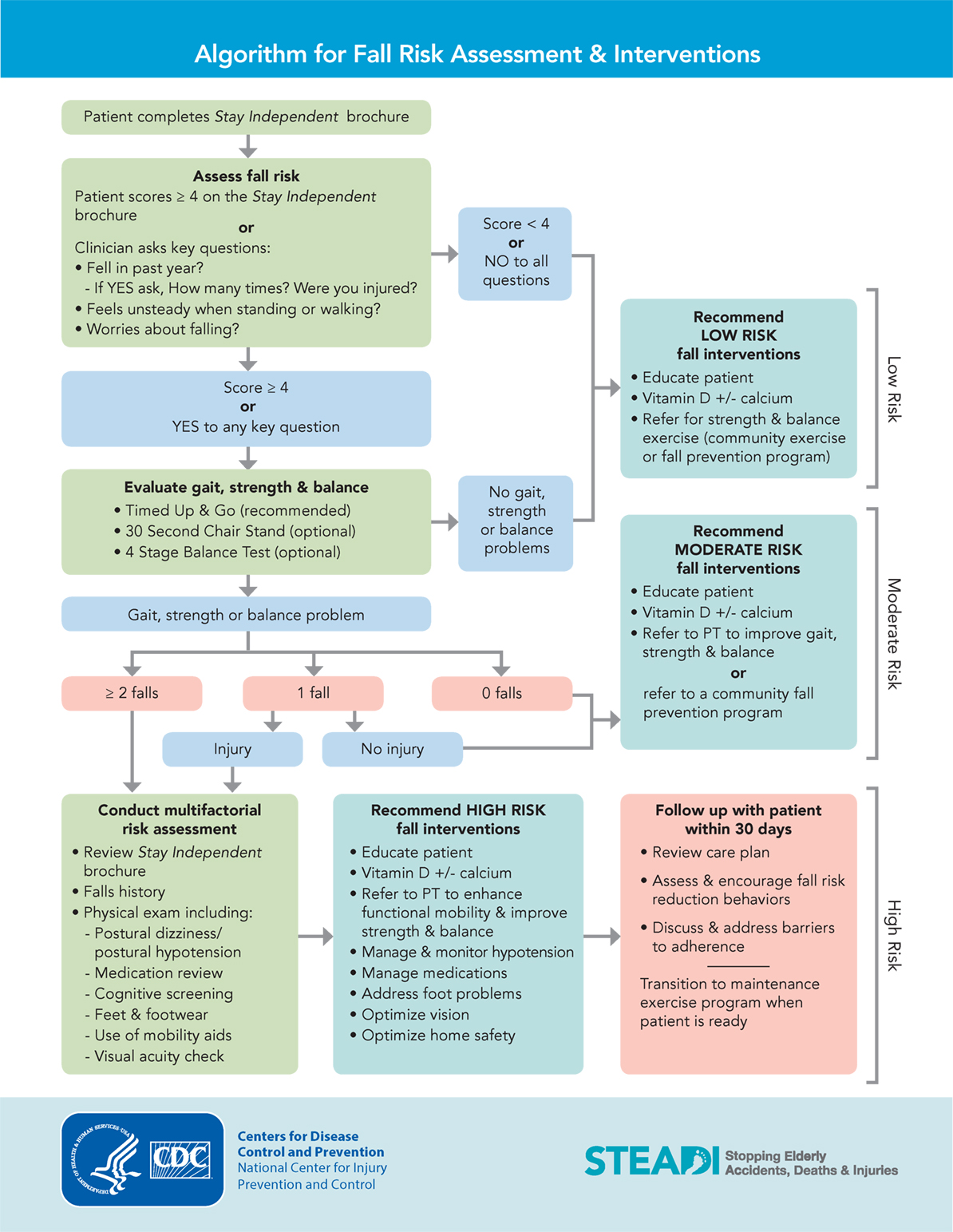4 Simple Techniques For Dementia Fall Risk
4 Simple Techniques For Dementia Fall Risk
Blog Article
The Best Guide To Dementia Fall Risk
Table of ContentsExamine This Report on Dementia Fall RiskAll about Dementia Fall RiskSome Known Facts About Dementia Fall Risk.Some Known Questions About Dementia Fall Risk.
A loss danger analysis checks to see just how likely it is that you will drop. It is primarily provided for older adults. The assessment generally consists of: This includes a series of questions regarding your general health and wellness and if you have actually had previous drops or troubles with balance, standing, and/or strolling. These devices check your stamina, equilibrium, and stride (the way you walk).STEADI consists of testing, analyzing, and intervention. Treatments are referrals that may lower your risk of falling. STEADI consists of 3 actions: you for your threat of succumbing to your danger aspects that can be enhanced to attempt to avoid falls (for instance, balance troubles, damaged vision) to reduce your risk of dropping by using efficient approaches (as an example, supplying education and sources), you may be asked a number of inquiries including: Have you dropped in the previous year? Do you feel unstable when standing or strolling? Are you fretted about dropping?, your copyright will examine your stamina, equilibrium, and gait, using the adhering to fall assessment devices: This examination checks your stride.
You'll rest down once again. Your company will examine for how long it takes you to do this. If it takes you 12 secs or more, it might suggest you go to greater danger for a fall. This test checks strength and balance. You'll sit in a chair with your arms crossed over your chest.
The positions will obtain more challenging as you go. Stand with your feet side-by-side. Move one foot midway onward, so the instep is touching the huge toe of your various other foot. Move one foot completely in front of the various other, so the toes are touching the heel of your other foot.
The Definitive Guide for Dementia Fall Risk
A lot of falls happen as a result of multiple adding variables; consequently, taking care of the threat of dropping starts with recognizing the aspects that add to drop risk - Dementia Fall Risk. Some of the most relevant threat factors include: Background of previous fallsChronic clinical conditionsAcute illnessImpaired stride and balance, reduced extremity weaknessCognitive impairmentChanges in visionCertain high-risk medicines and polypharmacyEnvironmental elements can also enhance the threat for drops, including: Poor lightingUneven or harmed flooringWet or unsafe floorsMissing or damaged handrails and order barsDamaged or poorly fitted tools, such as beds, wheelchairs, or walkersImproper use assistive devicesInadequate supervision of individuals living in the NF, including those that display hostile behaviorsA successful fall threat monitoring program calls for a comprehensive scientific assessment, with input from all members of the interdisciplinary group

The care strategy must also include interventions that are system-based, such as those that advertise a secure environment (appropriate lighting, hand rails, get bars, and so on). The performance of the treatments should be assessed occasionally, and the care plan changed as essential to mirror changes in the loss risk evaluation. Applying a fall risk administration system using evidence-based finest practice can reduce the occurrence of drops in the NF, while restricting the possibility for fall-related injuries.
10 Simple Techniques For Dementia Fall Risk
The AGS/BGS guideline advises evaluating all grownups aged 65 years and older for loss threat annually. This testing consists of asking clients whether they have actually fallen 2 or more times in the past year or looked for medical interest for a loss, or, if they have actually not dropped, whether they really feel unstable when strolling.
People site that have actually dropped when without injury needs to have their equilibrium and gait examined; those with gait or balance problems must read the full info here receive extra evaluation. A background of 1 fall without injury and without gait or balance issues does not require further assessment past continued annual fall threat screening. Dementia Fall Risk. A fall risk analysis is called for as part of the Welcome to Medicare examination

Some Known Factual Statements About Dementia Fall Risk
Recording a drops history is just one of the quality signs for fall avoidance and management. A vital component of risk analysis is a medication review. Numerous classes of medications enhance fall risk (Table 2). Psychoactive medicines particularly are independent predictors of drops. These drugs tend to be sedating, change the sensorium, and impair equilibrium and gait.
Postural hypotension can frequently be reduced by decreasing the dose of blood pressurelowering drugs and/or quiting drugs that have orthostatic hypotension as an adverse effects. Usage of above-the-knee support pipe and resting with the head of the bed elevated may also decrease postural decreases in high blood pressure. The recommended components of a fall-focused physical exam are received Box 1.

A pull time more than or equivalent to 12 secs recommends high loss risk. The 30-Second Chair Stand test evaluates lower extremity stamina and balance. Being unable to stand from a chair of knee elevation without using one's arms shows raised autumn risk. The 4-Stage Equilibrium test evaluates static equilibrium by having the individual stand in 4 settings, each considerably more tough.
Report this page